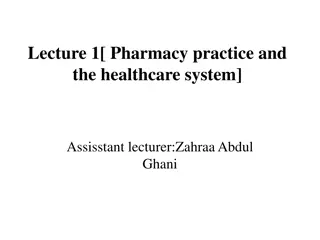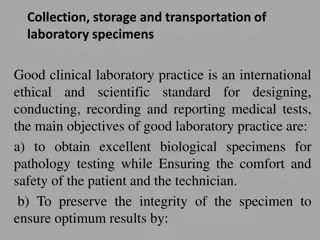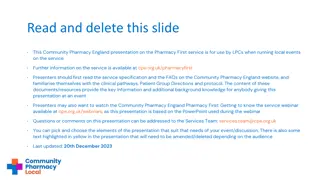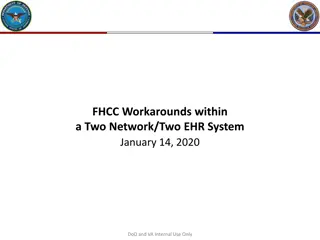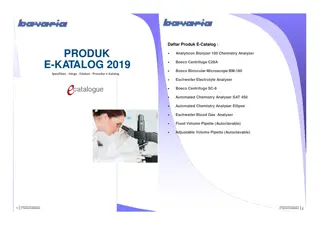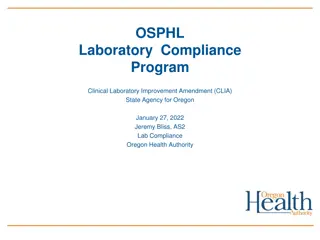Clinical Pharmacy Laboratory DM and Insulin Dosing Regimens
This comprehensive content covers various insulin dosing regimens used in clinical pharmacy laboratories for patients with diabetes mellitus. It includes examples of dosing regimens before meals and at bedtime, methods of insulin administration, vial images, mixing of different types of insulin, and stability considerations. The content emphasizes the importance of proper insulin dosing and administration in managing diabetes effectively.
Download Presentation

Please find below an Image/Link to download the presentation.
The content on the website is provided AS IS for your information and personal use only. It may not be sold, licensed, or shared on other websites without obtaining consent from the author. Download presentation by click this link. If you encounter any issues during the download, it is possible that the publisher has removed the file from their server.
E N D
Presentation Transcript
Clinical pharmacy laboratory DM
B-Examples of insulin dosing regimen: Regime n Before** breakfast Before** lunch Before** dinner bedtime 1 1/3 of the total daily dose 2/3 of the total daily dose 2/3 as I .A.I 1/3 as S.A.I ) 1/2 as I .A.I 1/2 as S.A.I ( ) ( 2 2/3 of the total daily dose 1/6 of the total daily dose given as S.A.I 1/6 of the total daily dose given as I . A . I 2/3 as I .A.I 1/3 as S.A.I 3 1/4 of the total daily dose as S.A.I 1/4 of the total daily dose as S.A.I 1/4 of the total daily dose as S.A.I 1/4 of the total daily dose as I .A.I 4 1/5 of the total daily dose as S.A.I and 1/5 of the total daily dose as L .A.I 1/5 of the total daily dose as S.A.I 1/5 of the total daily dose as S.A.I and 1/5 of the total daily dose as L .A.I
Method one :the morning dose of S.A.I cover the breakfast meal, the I.A.I cover the noon meal, the evening dose of S.A.I cover the evening meal, the I.A.I provide the basal insulin during the night and cover any snack which is ingested . Method two: is a variation of method one, it is the same except that the evening dose of I.A.I is given as a third injection at bedtime. This method may be useful in patient in whom nocturnal hypoglycemia and morning hyperglycemia are particularly troublesome. Since the administration of I.A.I at bedtime will delay the peak effect of it so that it occurs at approximately 7 a.m. Method three: consist of three equal doses of S.A.I before each meal and a dose of I.A.I at bedtime to provide basal insulin level at night. This regimen gives the patient more flexibility to the timing and size of his (her) meals. Method four: the three doses of the S.A.I will cover the meals while the twice daily dose of the L.A.I provide the insulin level throughout the day. It give some flexibility to the patient in that if he choose to skip a meal , he can omit the premeal dose of S.A.I , if he choose to eat a larger meal than the usual , he can increase the premeal dose of S.A.I
) . (
Mixing of insulins: Regular Insulin may be mixed with NPH in any proportion and the resultant mixture is stable for at least 1 month at room temperature without change in the kinetic property of the regular(3). In contrast, the rapid action of regular insulin is significantly blunted when mixed with Lente or Ultrlente insulin. (The excess zinc in Lente preparations binds the regular insulin Converting it to intermediate acting form). When the two insulins are mixed just before the injection, the clinical importance of this effect appear to be minimal (1) *Lente and Ultrlente may be mixed in any proportion at any time and are stable for long time (3).
Storage of insulin: The pharmacists can advice the patient that: A-Any unopened insulins are stored refrigerated (2-8 C0) (But not in the freezer) and the expiration date printed on the vials is used for unopened, refrigerated insulins(2) B-Insulin's vial that are currently in use is kept at room temperature (injection of cold insulin is uncomfortable) and can be used for 1 month (1,3) .
Rx1 Mr. Ahmed was recently diagnosed as having type 1 diabetes mellitus and entered the hospital in which he stabilized on 30 unit insulin daily. Q1-What are the differences between type 1( Insulin dependent diabetes mellitus: IDDM) and type 2 (Non Insulin dependent diabetes mellitus :NDDM) ? Q2-What are the available types of insulins now a day? Q3- How can this insulin dose (i.e. the 30 unit daily) be administered in a way to mimic the physiologic release of insulin from pancreas? And what is the idea behind each method? Q4-What are the usual body sites for S.C injection of insulin? And how we can minimize the fat hypertrophy that may occurs at the injection's sites?
Q5-How should the patient be instructed about? A- Agitation of insulin that present as suspension? B- Withdrawal of insulin dose from the vial? C-Mixing of short acting insulin (S.I.A) and other types of insulin in the same syringe? D-Storage and stability of insulin? Q6- You noticed that the patient use the insulin syringe for one injection only and then discarding it!!! Is this true practice? Q7-knowing that hypoglycemia is the major side effect of insulin what are the symptoms of it and how mild hypoglycemia can be managed? Q8- If the patient has a problem in withdrawing the correct no. of unit of insulin due to limited vision!!!! What option available for such problem?


























